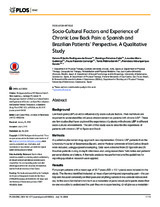Mostrar el registro sencillo del ítem
Socio-cultural factors and experience of chronic low back pain: a Spanish and Brazilian patients’ perspective. A qualitative study
| dc.contributor.author | Rodrigues-de-Souza, Daiana Priscila | |
| dc.contributor.author | Palacios-Ceña, Domingo | |
| dc.contributor.author | Moro-Gutiérrez, Lourdes | |
| dc.contributor.author | Rezende Carmargo, Paula | |
| dc.contributor.author | Salvini, Tania Fátima | |
| dc.contributor.author | Alburquerque Sendín, Francisco | |
| dc.date.accessioned | 2023-12-19T10:48:18Z | |
| dc.date.available | 2023-12-19T10:48:18Z | |
| dc.date.issued | 2016 | |
| dc.identifier.issn | 1932-6203 | |
| dc.identifier.uri | http://hdl.handle.net/10396/26392 | |
| dc.description.abstract | Background Low back pain (LBP) could be influenced by socio-cultural factors. Pain narratives are important to understand the influence of environment on patients with chronic LBP. There are few studies that have explored the experience of patients with chronic LBP in different socio-cultural environments. The aim of this study was to describe the experience of patients with chronic LBP in Spain and Brazil. Methods A qualitative phenomenology approach was implemented. Chronic LBP patients from the University Hospital of Salamanca (Spain), and/or Federal University of São Carlos (Brazil) were included, using purposeful sampling. Data were collected from 22 Spanish and 26 Brazilian patients during in-depth interviews and using researchers’ field notes and patients' personal diaries and letters. A thematic analysis was performed and the guidelines for reporting qualitative research were applied. Results Forty-eight patients with a mean age of 50.7 years (SD: ± 13.1 years) were included in the study. The themes identified included: a) ways of perceiving and expressing pain—the participants focused constantly on their pain and anything outside it was considered secondary; b) the socio-familial environment as a modulator of pain—most participants stated that no one was able to understand the pain they were experiencing; c) religion as a modulator of pain—all Brazilian patients stated that religious belief affected the experience of pain; and d) socio-economic and educational status as a modulator of pain—the study reported that economic factors influenced the experience of pain. Conclusions The influences of LBP can be determined based on the how a patient defines pain. Religion can be considered as a possible mechanism for patients to manage pain and as a form of solace. | es_ES |
| dc.format.mimetype | application/pdf | es_ES |
| dc.language.iso | eng | es_ES |
| dc.publisher | PLOS | es_ES |
| dc.rights | https://creativecommons.org/licenses/by/4.0/ | es_ES |
| dc.source | Rodrigues-de-Souza DP, Palacios-Ceña D, Moro-Gutiérrez L, Camargo PR, Salvini TF, Alburquerque-Sendín F (2016) Socio-Cultural Factors and Experience of Chronic Low Back Pain: a Spanish and Brazilian Patients’ Perspective. A Qualitative Study. PLoS ONE 11(7): e0159554 | es_ES |
| dc.subject | Low back pain | es_ES |
| dc.subject | Socio-cultural factors | es_ES |
| dc.subject | Environment | es_ES |
| dc.subject | Chronic patients | es_ES |
| dc.subject | Spain | es_ES |
| dc.subject | Brazil | es_ES |
| dc.title | Socio-cultural factors and experience of chronic low back pain: a Spanish and Brazilian patients’ perspective. A qualitative study | es_ES |
| dc.type | info:eu-repo/semantics/article | es_ES |
| dc.relation.publisherversion | http://dx.doi.org/10.1371/journal.pone.0159554 | es_ES |
| dc.rights.accessRights | info:eu-repo/semantics/openAccess | es_ES |

